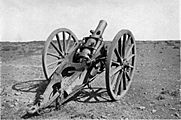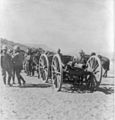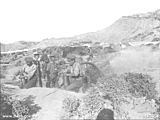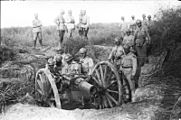BL 5-inch howitzer facts for kids
Quick facts for kids Ordnance BL 5-inch howitzer |
|
|---|---|
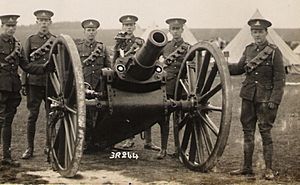
Territorial Force gunners with howitzer in camp pre-WWI
|
|
| Type | Field howitzer |
| Place of origin | United Kingdom |
| Service history | |
| In service | 1895 – 1919 |
| Used by | |
| Wars | Mahdist War Second Boer War First World War |
| Specifications | |
| Mass | 2,672 lb (1,212 kg) |
| Barrel length | 42 inches (1.07 m) bore (8.4 calibres) |
|
|
|
| Shell | 50 lb (22.7 kg) Common shell 50 lb (22.7 kg) Lyddite shell 40 lb (18.1 kg) Amatol shell |
| Calibre | 5-inch (127.0 mm) |
| Breech | 3-motion, interrupted screw |
| Recoil | 5.5 in (140 mm), Hydro-spring constant |
| Carriage | Wheeled, box trail |
| Elevation | -5° - 45° |
| Muzzle velocity | 788 ft/s (240 m/s) |
| Effective firing range | 4,800 yards (4,400 m) (50 lb shell); 6,500 yards (5,900 m) (40 lb shell) |
| Filling weight | 9 pounds 15 ounces (4.51 kg) (Lyddite) 5 pounds (2.27 kg) (Amatol) |
The Ordnance BL 5-inch howitzer was a powerful type of cannon used by the British army. It was first introduced in 1895. This howitzer was designed to fire explosive shells. These shells were very different from the shrapnel shells used by other field guns at the time.
Contents
How it was Used in Wars
The 5-inch howitzer saw action in several important conflicts. It was used by soldiers from the United Kingdom, the Kingdom of Romania, and the Russian Empire.
Fighting in Sudan
The howitzer was first used in battle during the Mahdist War in Sudan. This happened at the Battle of Omdurman in 1898. It was a big moment because these were the first British guns to fire new Lyddite shells in a real fight. Lyddite was a powerful explosive.
The Second Boer War
Later, the howitzer was used in the Second Boer War (1899-1902). However, it had some problems there. The Lyddite shells often didn't explode properly. Also, the howitzer was quite heavy. This made it hard to move around quickly like a field gun. Its range was also too short for attacking enemy forts. But it did help in some battles in Natal. It could get close enough to hit Boer soldiers hiding in trenches.
World War I Service
By 1908, newer and better howitzers were available. The British Regular Army replaced the 5-inch howitzer with the QF 4.5-inch howitzer.
However, some British army groups, called the Territorial Force, kept using the 5-inch howitzer. They used it during World War I until 1916. It was notably used in the Battle of Gallipoli and in the East African campaign.
During World War I, a lighter shell was introduced. This new shell weighed 40 pounds (about 18 kg) and used a different explosive called Amatol. The amount of gunpowder was also increased. These changes made the howitzer able to shoot much farther. Its maximum range went from 4,800 yards to 6,500 yards (about 5,900 meters). But there was a mistake: the new shells were sent to Gallipoli without the right instructions or tools. This meant they couldn't be used at first.
Gallery
-
In action on Gallipoli, 1915.
Ammunition Details
The 5-inch howitzer fired different types of shells.
- The original shells weighed 50 pounds (about 22.7 kg). They were either "Common shells" or "Common Lyddite shells."
- Later, a lighter 40-pound (about 18.1 kg) shell with Amatol explosive was used.
- The howitzer also used a special "friction tube" to ignite the gunpowder and fire the shell.
See also
Where to See One Today
You can still see examples of the Ordnance BL 5-inch howitzer in a few places:
- At the National Military Museum in Bucharest, Romania


